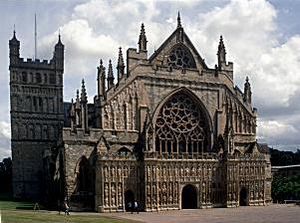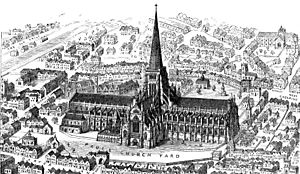William Alley facts for kids
William Alley (also known as Alleyn or Alleigh) was an important church leader in England. He lived from about 1510 to 1570. William Alley served as the Bishop of Exeter when Queen Elizabeth I was in charge. He was part of the Anglican Church. In 1534, William Alley married Sybil Bodleigh. They had eight children together.
William Alley is also known for his book, Poor Man's Librarie. This book was printed in London in 1565. Its full title was Lectures upon the First Epistle of Saint Peter. These were talks he gave publicly at St Paul's Cathedral in London in 1560. The book also included helpful notes on different topics.
William Alley's Life Story
William Alley was born in Wycombe, Bucks. He went to school at Eton College. Later, he studied at both Cambridge and Oxford universities.
Becoming a Bishop
William Alley worked at St Paul's Cathedral in London. He was a "prebendary," which means he was a special priest there. Queen Elizabeth chose him to become the new Bishop of Exeter. The previous bishop had been removed.
On April 27, 1560, the Queen officially asked the church leaders in Exeter to elect him. This request was delivered on May 5. The election happened on May 20. William Alley officially became a bishop on July 14, 1560.

Changes at Exeter Cathedral
When William Alley became bishop, the church in Exeter was not very rich. To help, he was given control of a church area called Honiton. He held church ceremonies there. He even performed ordinations, which is when new priests are appointed.
The money for the cathedral and its leaders was very low. So, Bishop Alley made a big change. With everyone's agreement and the Queen's permission, he reduced the number of canons. Canons were important church officials. He changed the number from twenty-four to just nine. This rule was made on February 22, 1561.
Later, some people tried to change this rule back. But it was too late. The new rule had been in place for a long time. It was also approved by the Queen.
His Final Years
William Alley led the diocese of Exeter for about nine and a half years. He passed away on April 15, 1570. He was 60 years old. He was buried inside Exeter Cathedral.


